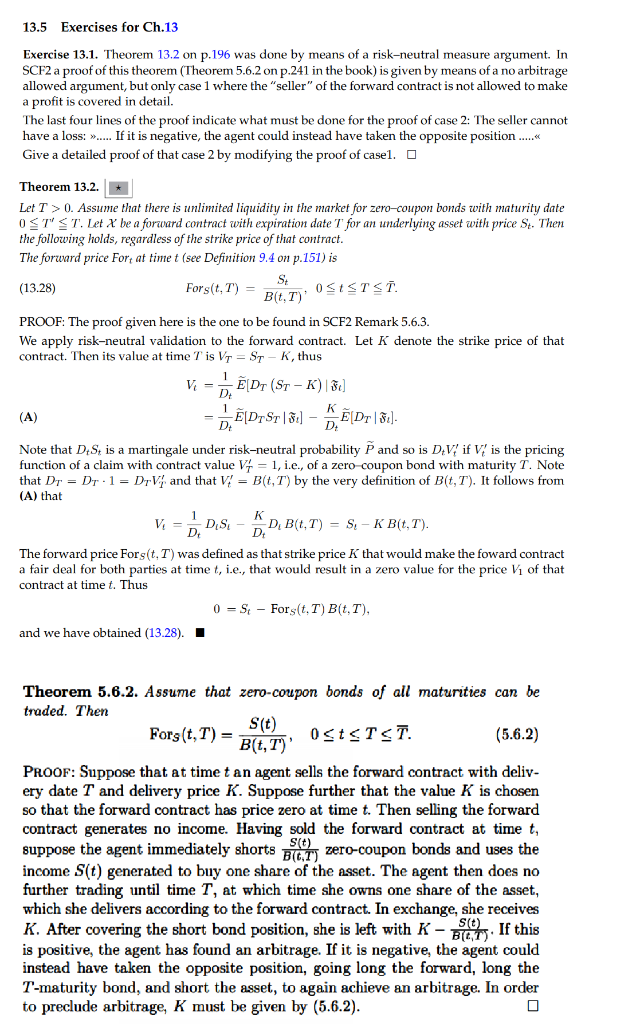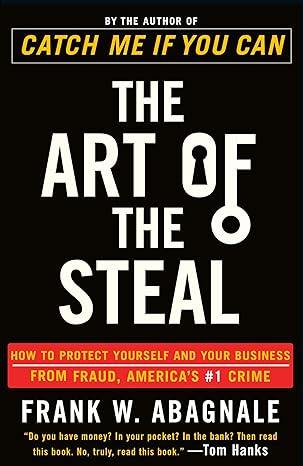
13.5 Exercises for Ch.13 Exercise 13.1. Theorem 13.2 on p.196 was done by means of a risk-neutral measure argument. In SCF2 a proof of this theorem (Theorem 5.6.2 on p.241 in the book) is given by means of a no arbitrage allowed argument, but only case 1 where the "seller" of the forward contract is not allowed to make a profit is covered in detail. The last four lines of the proof indicate what must be done for the proof of case 2: The seller cannot have a loss: ..... If it is negative, the agent could instead have taken the opposite position .....* Give a detailed proof of that case 2 by modifying the proof of casel. O Theorem 13.2. * Let T > 0. Assume that there is unlimited liquidity in the market for zero-coupon bonds with maturity date OST" ST. Let X be a forward contract with expiration date 7 for an underlying asset with price St. Then the following holds, regardless of the strike price of that contract. The foruvrd price for at time t (see Definition 9.4 on p.151) is St (13.28) Fors(t, T) B(1,7) OSISTST PROOF: The proof given here is the one to be found in SCF2 Remark 5.6.3. We apply risk-neutral validation to the forward contract. Let K denote the strike price of that contract. Then its value at time is VST - K, thus LDT (ST-K)30) D. (A) DrSr5] D D: Note that D St is a martingale under risk-neutral probability and so is D:V/ if V' is the pricing function of a claim with contract value V1 = 1, i.e., of a zero-coupon bond with maturity T. Note that Dr = Dr.1= Dr Vand that V! = B(t, T) by the very definition of B(t, T). It follows from (A) that 1 K DS D D, B(t,T) = S, - K B(t, T). D. The forward price Fors(t, T) was defined as that strike price K that would make the foward contract a fair deal for both parties at time t, i.e., that would result in a zero value for the price V1 of that contract at time t. Thus 0 = $x Fors(t. T) Bit, T), and we have obtained (13.28). I K Dr Fel Theorem 5.6.2. Assume that zero-coupon bonds of all maturities can be traded. Then Fors(t, T) = S(t) (5.6.2) OstCTCT. B(t, T)' PROOF: Suppose that at time t an agent sells the forward contract with deliv- ery date T and delivery price K. Suppose further that the value K is chosen so that the forward contract has price zero at time t. Then selling the forward contract generates no income. Having sold the forward contract at time t, suppose the agent immediately shorts B07) zero-coupon bonds and uses the income S(t) generated to buy one share of the asset. The agent then does no further trading until time T, at which time she owns one share of the asset, which she delivers according to the forward contract. In exchange, she receives K. After covering the short bond position, she is left with K - B17. If this is positive, the agent has found an arbitrage. If it is negative, the agent could instead have taken the opposite position, going long the forward, long the T-maturity bond, and short the asset, to again achieve an arbitrage. In order to preclude arbitrage, K must be given by (5.6.2). 13.5 Exercises for Ch.13 Exercise 13.1. Theorem 13.2 on p.196 was done by means of a risk-neutral measure argument. In SCF2 a proof of this theorem (Theorem 5.6.2 on p.241 in the book) is given by means of a no arbitrage allowed argument, but only case 1 where the "seller" of the forward contract is not allowed to make a profit is covered in detail. The last four lines of the proof indicate what must be done for the proof of case 2: The seller cannot have a loss: ..... If it is negative, the agent could instead have taken the opposite position .....* Give a detailed proof of that case 2 by modifying the proof of casel. O Theorem 13.2. * Let T > 0. Assume that there is unlimited liquidity in the market for zero-coupon bonds with maturity date OST" ST. Let X be a forward contract with expiration date 7 for an underlying asset with price St. Then the following holds, regardless of the strike price of that contract. The foruvrd price for at time t (see Definition 9.4 on p.151) is St (13.28) Fors(t, T) B(1,7) OSISTST PROOF: The proof given here is the one to be found in SCF2 Remark 5.6.3. We apply risk-neutral validation to the forward contract. Let K denote the strike price of that contract. Then its value at time is VST - K, thus LDT (ST-K)30) D. (A) DrSr5] D D: Note that D St is a martingale under risk-neutral probability and so is D:V/ if V' is the pricing function of a claim with contract value V1 = 1, i.e., of a zero-coupon bond with maturity T. Note that Dr = Dr.1= Dr Vand that V! = B(t, T) by the very definition of B(t, T). It follows from (A) that 1 K DS D D, B(t,T) = S, - K B(t, T). D. The forward price Fors(t, T) was defined as that strike price K that would make the foward contract a fair deal for both parties at time t, i.e., that would result in a zero value for the price V1 of that contract at time t. Thus 0 = $x Fors(t. T) Bit, T), and we have obtained (13.28). I K Dr Fel Theorem 5.6.2. Assume that zero-coupon bonds of all maturities can be traded. Then Fors(t, T) = S(t) (5.6.2) OstCTCT. B(t, T)' PROOF: Suppose that at time t an agent sells the forward contract with deliv- ery date T and delivery price K. Suppose further that the value K is chosen so that the forward contract has price zero at time t. Then selling the forward contract generates no income. Having sold the forward contract at time t, suppose the agent immediately shorts B07) zero-coupon bonds and uses the income S(t) generated to buy one share of the asset. The agent then does no further trading until time T, at which time she owns one share of the asset, which she delivers according to the forward contract. In exchange, she receives K. After covering the short bond position, she is left with K - B17. If this is positive, the agent has found an arbitrage. If it is negative, the agent could instead have taken the opposite position, going long the forward, long the T-maturity bond, and short the asset, to again achieve an arbitrage. In order to preclude arbitrage, K must be given by (5.6.2)







